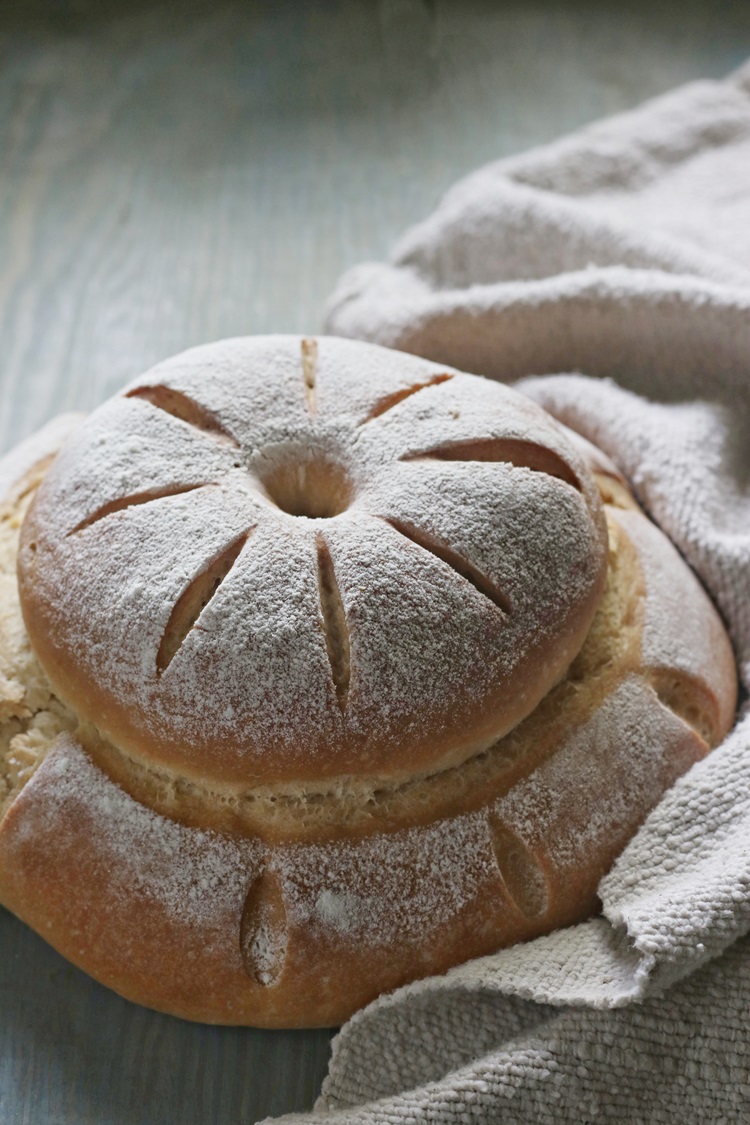Its Bread Baking Babes time of the month, again. This time Cathy picked an Early American Cottage Loaf for us to bake. A Cottage Loaf is a traditional type of white bread originally from South England. It is shaped like two round loaves, one on top of another. The early pioneers brought it with them when they came to the Americas.

The loaf is characterised by its shape, which is essentially that of two round loaves in one. The smaller round loaf sits on top the slightly bigger one, like a top knot! This shaping style is somewhat similar to the French Brioche and Pain Chapeau (Hat Bread). No one seems to know the reason why this bread is shaped like it is. One suggestion is that it was a space-saving tactic in tiny bread ovens.
As far as I can make out, there are very few differences between the Early American Cottage Loaf and the English Cottage Loaf. The English mostly used ordinary flour and baked them free-form in ovens. The Pioneer Americans used to blend available grains and this resulted in different texture. They also baked this bread in cast iron pots hanging in the fireplace.
The Cottage Loaf seems to have been around since the early 19th century, perhaps even earlier. They were very popular until the Second World War. The British George Orwell wrote in his article “In defence of English Cooking”(1945): “Still, if there is anything quite as good as the soft part of the crust from an English cottage loaf (how soon shall we be seeing cottage loaves again?) I do not know of it.”

The Cottage Loaf started disappearing in the later part of the twentieth century. Apparently, changing food fashion and trends sent it into oblivion. The bread had too much crust and so was not suitable for sandwiches or toast. It was also considered a difficult bread to make, as the dough had to be elastic but stiff enough to keep the top knot shape. It was important to get the size of the two round balls of dough right. A heavy top loaf would flatten the lower one. A very light top loaf could cause it to fall off!
This recipe is adapted from the original which uses a mix of grains. In the present pandemic situation, I didn’t have oats or a seed mix to use. I had some pumpkin seeds which I added to the processor right at the beginning. That wasn’t a great idea because it broken up in the dough. I baked a white bread with some whole wheat flour in it. I also baked my bread on a baking tray. So my bread is really more of an English Cottage Loaf than a pioneer style American bread. Please see the original recipe if you would like to use a mix of grains and seeds. They would definitely add to the flavour of the bread.

I personally didn’t find the bread too difficult to make. Yes, it is important to make sure you divide the dough into 1/3 and 2/3 to get evenly balanced rounds of dough. I think the Cottage Loaf is a nice hearty and comforting bread. It does make a good sandwich, even if a slightly odd shaped one. If you cut each slice in half, it makes excellent toast too.
- 1 1/4cups water
- 1 1/2tbsp honey
- 1 1/2tsp active dried yeast
- 2tbsp coconut oilor any other oil
- 2 3/4cups all purpose flour
- 1cup whole wheat flour
- 1 1/2tsp salt
- Handful of mixed seeds(sunflower, watermelon, pumpkin, flax seeds, etc)
-
Warm about 1/4 cup of the water and mix in the honey and the yeast. Keep aside for 10 minutes or so till frothy.
-
Put the frothy yeast, and all the other ingredients, except the remaining water and the seeds into the bowl of your mixer/ machine. Add enough water and knead until the dough is smooth and elastic. Turn the dough out and knead in the seeds, if using. Shape the dough into a ball. Place in a well-oiled bowl, turning to coat well. Cover loosely and let it rise for 45 minutes to an hour.
-
Do a stretch and a fold of the dough in the bowl itself. Cover again and let it rise for about an hour, or till almost double in volume.
-
Turn dough onto a lightly floured surface and lightly knead to remove air bubbles. Cut the dough into a 1/3 and 2/3 portions. Let dough relax for 15 minutes.
-
Shape each section into a round, tight ball. Place the larger ball on a lightly greased baking sheet. Using a sharp knife or lame, cut a cross, about 1 ½ inches across and not too deep, in the top centre of the larger ball of dough.
-
Brush the surface with water and place the smaller ball of dough on top. Flour the end of a wooden dowel, spoon or use your pointing finger to press through right down the centre of both balls of dough. Cover loosely and let the dough rise until an indentation remains after lightly touching dough.
-
Just before baking, stick wooden dowel, spoon or finger into hole again to open it up a bit. Using a sharp knife or lame, make 8 long slashes around the top and 12 smaller slashes around the bottom of the loaf.
-
Bake at 190C (375F) for about 35 to 40 minutes till brown and done. The bread should sound hollow when tapped. Cool completely on a rack before slicing.
The Bread Baking Babes are –
Bread Baking Babe Bibliothécaire – Katie
Blog from OUR kitchen – Elizabeth
My Kitchen In Half Cups – Tanna
Karen’s Kitchen Stories – Karen
The post Cottage Loaf appeared first on My Diverse Kitchen - A Vegetarian Blog.
